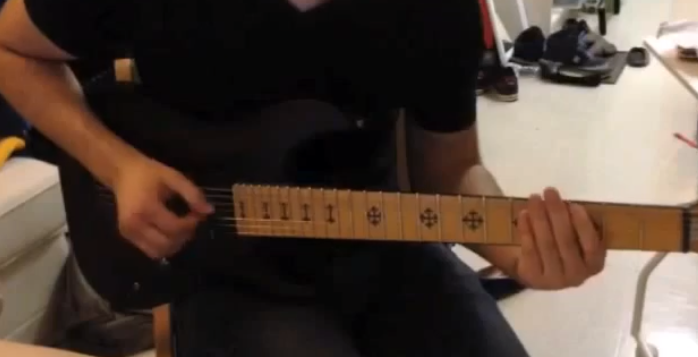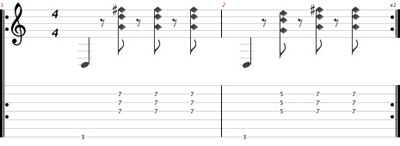Fun Comping with a Seven-String Guitar and Harmonics

Trying to make a seven-string guitar play like a six-string is very tough, especially if you've been a bluesy player your whole life.
The “thumb over the neck” approach doesn't work as well. Also, some seven-strings sound like a middle ground between a guitar and a bass (like the one I used for this example), which makes openly strumming “cowboy chords” a terrible decision.
So while companies are still trying to figure out how to truly understand the construction of seven-string guitars (They're doing a great job so far!), it's best to treat a hybrid instrument like its own unique instrument.
Here's a fun example I came up with while my six-string was in the shop. The chords are D, G, D/F#, E minor. It's always a good time to play around with natural harmonics because of the register and tonal change between a fretted and un-fretted note. It also can lend itself to percussive playing, which really only comes out in the video, not the tab.
The tab in this case is more of an outline than listening/seeing the example played. You often see players like Tommy Emmanuel or Justin King and other solo acoustic guys making more use of harmonics, and I'm not sure why. Possibly because they don't have a band to play with, so they have to get every possible sound out of the instrument. But, electric or acoustic, this is good practice.
The example requires a little bit of a hand stretch, but it's not too extreme, especially if you're tried modern shredding (Rusty Cooley for sure). There are really two tough parts. The first is getting your fingers directly over the frets. Try not to rely on high compression to make them ring out. Getting very accurate is important for all kinds of playing, slow or fast.
The other is the final eighth notes. At faster speeds, retaining the accuracy needed to make the harmonics ring true is very hard (a harmonic melody Steve Vai used a lot). Also this may be tough for inexperienced fingerpickers, as eighth notes at 190 bpm aren't easy. I split the riff into three sections:
Example 1 is the D chord.

Example 2 is the G and D/F# chord

Example 3 is the E minor chord

Here's the video, slow then fast:
I hope you enjoy this challenge! If you have any questions or anything, feel free to reach out to me here or my YouTube channel.
Elliott Klein is a New York City-based guitarist/singer/songwriter who plays in Bright and Loud, Party Lights and many more.
Get The Pick Newsletter
All the latest guitar news, interviews, lessons, reviews, deals and more, direct to your inbox!









![Joe Bonamassa [left] wears a deep blue suit and polka-dotted shirt and plays his green refin Strat; the late Irish blues legend Rory Gallagher [right] screams and inflicts some punishment on his heavily worn number one Stratocaster.](https://cdn.mos.cms.futurecdn.net/cw28h7UBcTVfTLs7p7eiLe.jpg)
